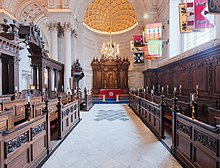
Back Capiella AN مصلى كنسي Arabic Capiella AST Kapella (memarlıq) Azerbaijani Капліца Byelorussian Капліца BE-X-OLD Параклис Bulgarian Chapel Breton Kapela BS Capella (arquitectura) Catalan


A chapel (from Latin: cappella) is a Christian place of prayer and worship that is usually relatively small. The term has several meanings. First, smaller spaces inside a church that have their own altar are often called chapels; the Lady chapel is a common type of these. Second, a chapel is a place of worship, sometimes interfaith,[1] that is part of a building, complex, or vessel with some other main purpose, such as a school, college, hospital, palace or large aristocratic house, castle, barracks, prison, funeral home, cemetery, airport, or a military or commercial ship.[2] Third, chapels are small places of worship, built as satellite sites by a church or monastery, for example in remote areas; these are often called a chapel of ease. A feature of all these types is that often no clergy were permanently resident or specifically attached to the chapel.
For historical reasons, chapel is also often the term used by independent or nonconformist denominations for their places of worship in England and especially in Wales, even where they are large and in practice they operate as a parish church.[3][4]
The earliest Christian places of worship are now often referred to as chapels, as they were not dedicated buildings but rather a dedicated chamber within a building. Most larger churches had one or more secondary altars which, if they occupied a distinct space, would often be called a chapel. In Russian Orthodox tradition, the chapels were built underneath city gates, where most people could visit them; a famous example is the Iberian Chapel.
Although chapels frequently refer to Christian places of worship, they are also found in Jewish synagogues and do not necessarily denote a specific denomination. In England—where the Church of England is established by law, interdenominational or interfaith chapels in such institutions may be consecrated by the local Anglican bishop. Chapels that are not affiliated with a particular denomination are commonly encountered as part of a non-religious institution such as a hospital, airport, university or prison.[5] Many military installations have chapels for the use of military personnel, normally under the leadership of a military chaplain.[6]
- ^ "Muslim prayers welcome at Pentagon chapel". CNN. Archived from the original on 7 March 2016. Retrieved 3 March 2016.
- ^ "CATHOLIC ENCYCLOPEDIA: Chapel". www.newadvent.org. Archived from the original on 9 March 2021. Retrieved 10 April 2005.
- ^ Wakeling, Christopher (August 2016). "Nonconformist Places of Worship: Introductions to Heritage Assets". Historic England. Archived from the original on 28 March 2017. Retrieved 28 March 2017.
- ^ Jones, Anthony (1996). Welsh Chapels. National Museum Wales. ISBN 9780750911627. Retrieved 28 March 2017.
- ^ Hewson, Chris (1 January 2010). "Multi-faith Spaces: Symptoms and Agents of Religious and Social Change". University of Manchester. Retrieved 14 September 2012.
- ^ "Royal Army Chaplains' Department". www.army.mod.uk. The British Army. Archived from the original on 19 March 2017. Retrieved 28 March 2017.
© MMXXIII Rich X Search. We shall prevail. All rights reserved. Rich X Search